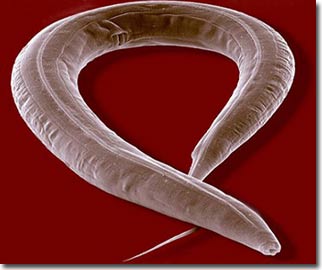The evolution of sleep
The roundworm C. elegans, the main subject of research, may be the key to opening the door to one of the central biological mysteries: Why we sleep. Researchers at the University of Pennsylvania School of Medicine have published in the journal Nature online Jan. 11, 2008 that the nematode also has a sleep-like state - a state inherent in most animals. The study explains the evolution and purpose of sleep and sleep-like states in animals.
In addition, related genetic research also brought new prospects for the use of C. elegans to identify sleep-regulating genes and drugs to treat sleep disorders.
The first author of the study, David M. Raizen - a medical doctor and a doctor of philosophy and assistant professor of neuroscience, collaborated with Penn Center researchers on sleep and prove that there is a passive phase in the development of this worm called lethargus. That stage has the same characteristics as sleep. Mr. Raizen explained: 'The human being receives

Researchers at the University of Pennsylvania School of Medicine have found that this nematode also has a sleep-like state.(Photo: ESA)
more active when sleeping, and so is this worm during the lethargus period. People sleep faster and deeper each time they fall asleep, this phenomenon also occurs in C. elegans' worms. By proving that worms are also sleeping, Raizen and his colleagues not only give evidence of the existence of sleep in all species in nature, but also provide a compelling hypothesis about the purpose of sleep.
Because the lethargus stage in the worm coincides with the phase of synaptic changes in the nervous system that occurs during the life cycle of the nematode, scientists have suggested that sleep is a necessary state to shape the nervous system. sutra. In other words, in order for the nervous system to grow and change, it takes time for rest activities. Several other researchers at Penn have demonstrated in mammals, synaptic changes occur during sleep. Lack of sleep makes these changes broken.
In addition, the team also used C. elegans as a specimen to identify sleep regulation genes. This gene encodes the kinase protein and is controlled by a small molecule called GMP . Previously there have been studies of genes that regulate sleep, but people do not think it is related to sleep. The study found the potential role of genes in regulating human sleep, thereby bringing new hope in the production of sleep disorder medications.
'The study opens a whole new page of sleep function,' according to Penn Center and co-author Allan I. Pack - a bachelor of medicine, a bachelor of surgery and a doctor of philosophy. Center for Neuroscience, Respiratory and Sleep at the University of Pennsylvania specializes in exploring, understanding the basic mechanisms of sleep and natural circadian rhythms, the formation of sleep disorders and the results of therapy .
Collaboration with Raizen and Pack also included John E. Zimmerman, Matthew H. Maycock, Uyen D, Ta, Meera V. Sundaram (Penn Center), and Young-jai You (Southwest Texas Medical University in Dallas). Research on National Institute of Neurological Disorders and Stroke (American National Institute of Neurological Disorders and Stroke), National Heart Lung and Blood Institute (National Heart, Lung, and Blood Institute), and National Alliance for Research on Schizophrenia and Depression (grant of national research on schizophrenia and depletion) funding.
- Research proves that crocodile legend
- The reason people have to sleep
- Sleeping a lot also causes illness
- Decode the phenomenon of saying dream when sleeping
- 5 reasons why you sleep more than 10 hours a day and still yawn
- 30 facts about sleep
- Sleep affects the color of the owl?
- People who struggled to get out of bed in the morning were really smart
- How many times do you wake up during the night?
- What happens when you stop breathing during sleep?
- How is sleeping properly?
- Discover a special brain area that keeps you awake
 Why do potatoes have eyes?
Why do potatoes have eyes? 'Tragedy' the world's largest carnivorous life: Death becomes ... public toilet
'Tragedy' the world's largest carnivorous life: Death becomes ... public toilet Tomatoes were once considered 'poisonous' for 200 years
Tomatoes were once considered 'poisonous' for 200 years Detecting microscopic parasites on human face
Detecting microscopic parasites on human face